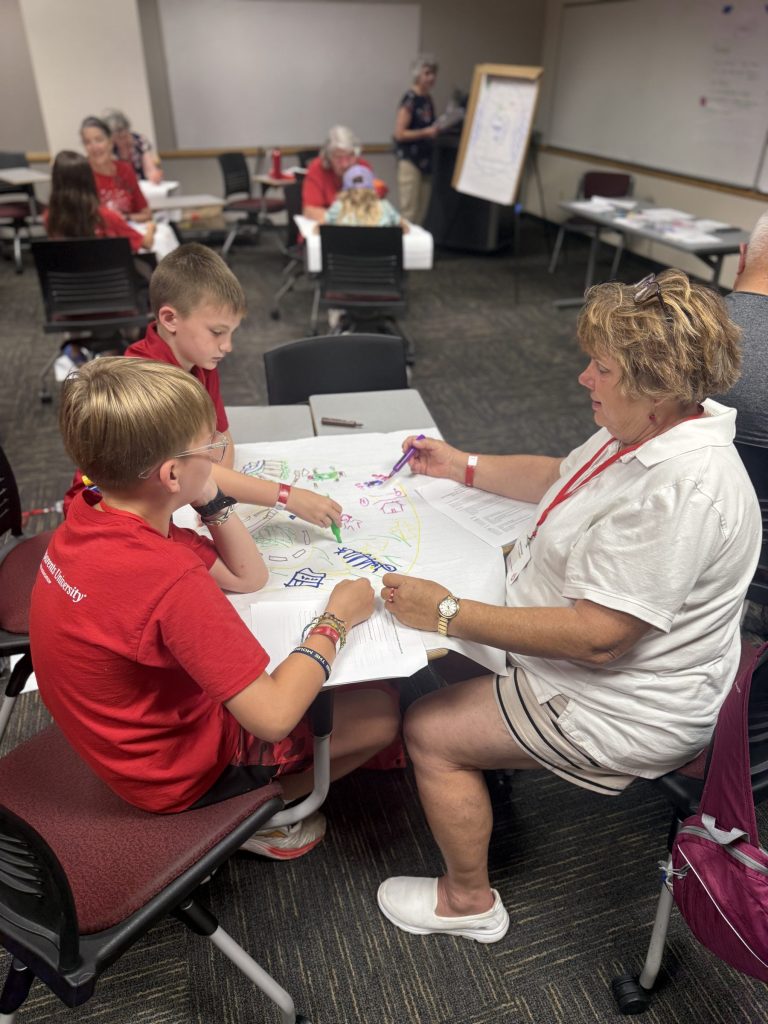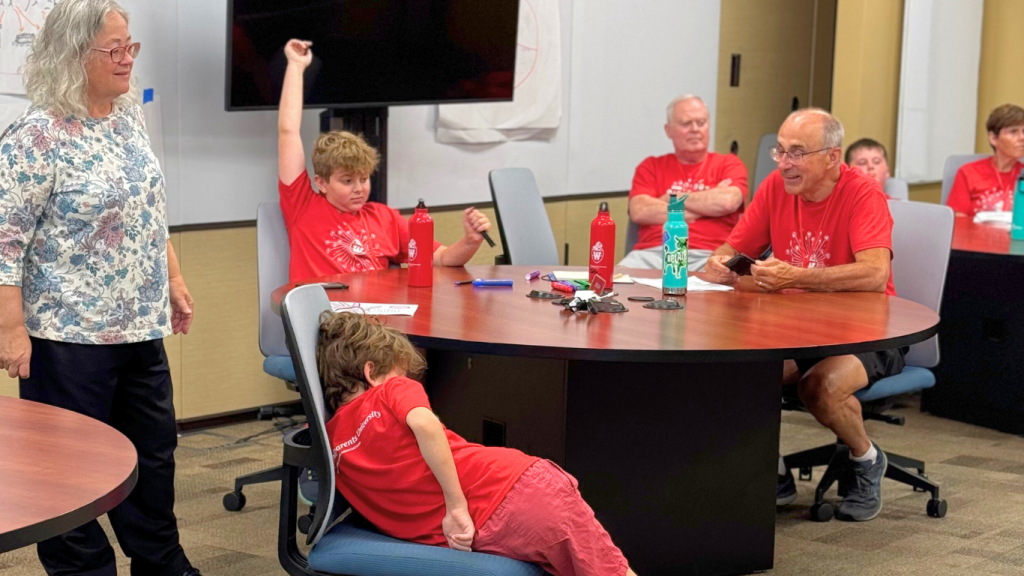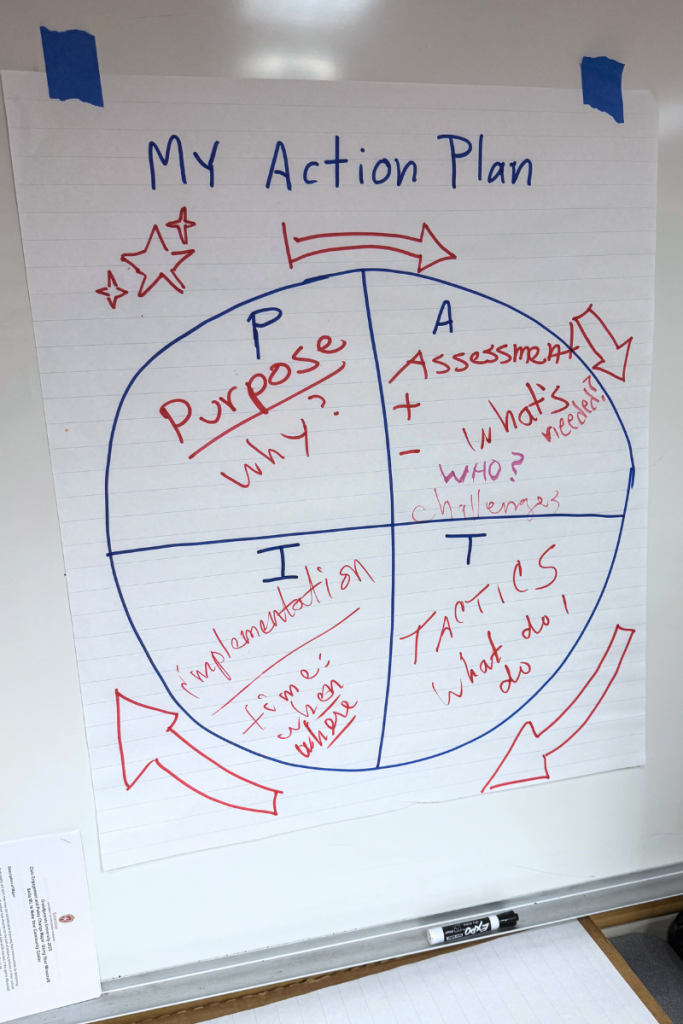When it comes to Minecraft, Camdyn and Dawson consider themselves builders. After going to Grandparent’s University (GPU) with their grandmother, Sara Draeger, they see Minecraft in a whole new way.
As part of this year’s GPU, UW-Madison Extension Community Development educators debuted a new course called “Using your Minecraft skills IRL* to make your community cooler.” The class utilized the concepts of community building within Minecraft to teach kids to become changemakers in their own (real-life) communities. “I would have never thought of the relationship between Minecraft and community service. Not being a Minecraft player, I thought making that connection was great,” said Draeger.
GPU is a Wisconsin Alumni Association (WAA) summer program for grandchildren and grandparents to attend together. They spend two days at UW-Madison, getting the college experience.

It’s an intergenerational activity that creates memories and offers hands-on learning opportunities in majors led by UW faculty and staff. Elizabeth McCrank, Community Leadership Specialist with Extension’s Community Development Institute, has taught the Civic Engagement major several times, but this is the first time she has incorporated Minecraft. “We want youth to understand that their voice matters, that they already have critical thinking and reasoning skills, and that they can make valuable contributions to their community. Our goal for GPU was to find a way to talk about civic engagement so that it makes sense to young people and inspires them to get involved,” said McCrank.
Why Minecraft?
Building communities within the game is very similar to real life. There are rules and norms developed by the game community. Players are able to grow (or mine) resources and use, save, or sell them to gain additional things that they need. There are loopholes that players like to share with one another when they find ways around the rules. And, there is project planning. Listen to a player talk about their next project, and you’ll hear the thought processes and steps that go into building.
In other words, Minecraft players understand how to build community and already have the skills to plan, solve problems, and work together. McCrank, who designed the class, set out to show youth the connection between Minecraft and real-life civic engagement, inspiring them to use their skills outside of the game. “The kids in the class haven’t necessarily shifted and realized that the things they do in the game are also happening in real life. And that is the point of what we’re doing here for two days. If we could just plant the seed that what they’re doing in the game is an actual skill that they can do outside of the game, then we’ve succeeded,” said McCrank.
Strengthening multi-generational relationships
While the ultimate goal of the class is to inspire youth to become engaged in their communities, it also gives grandparents a new way to communicate with a younger generation. “One grandparent said she was amazed at how they have their own language, and you know what? They do. They’ve got their own lingo, their own language. And that means they have their own thought system, and that’s really, really an amazing thing,” said McCrank. Introducing grandparents to that lingo gives them a new way to connect and inspire their grandchildren.
John Siebers, from Outagamie County, brought his two grandchildren this year. He has attended GPU several times with his grandsons, Auden from Appleton and Ezra from Milwaukee. Auden and Ezra are Minecraft experts. But, Sievers has never played. He was excited to see how the class would use Minecraft to teach civic engagement.

Watching the youth interact was one of his favorite parts. “The steps- all the kids relayed the steps they had to take to accomplish an objective. Like Ezra’s Zombie arena, there are steps. And they’ve all experienced that. But they didn’t realize there are steps in real life.” Siebers loved how the instructors connected the game and real life. “It was neat to watch the engagement and how the instructors played off of that engagement to bring them back to ‘Hey, the same thing happens in real life.’”
Becoming changemakers
Youth did more than talk about civic engagement; they put their skills to work utilizing planning tools that communities often use. First, they mapped their own community. Then they discussed changes they would like to see. Using the PATI (Purpose, Assessment, Tactics, Implementation) framework, they worked with their grandparents to plan a project.
Ideas included adding a putting green to the local park, bringing penguins back to the Henry Vilas Zoo, and building a roller coaster in the backyard.
Asked what he took away from the class, Auden said, “That Minecraft can have stuff similar to real life.” He worked with his grandfather on a plan for something he’d like to see in Appleton. “One of the things that I put down was I want to build a Star Wars Museum. I can’t do that now, but if I have the chance to in the future, I would like to.”

The “creative mode” mindset
Minecraft has many game modes, each with different objectives. “Spectator mode” allows you to watch what is happening, without participating. In contrast, creative mode allows you to build and interact with others. When it comes to Minecraft, this group of youth is ready to create. “As soon as they heard an idea from someone in the class, they immediately started problem-solving,” said McCrank. Encouraging them to approach their community in a similar way is key.
“Civic engagement is about building the creative mode mindset, of thinking about not just going through my community, going through my day-to-day, but thinking critically about my community,” said McCrank, “It’s a difference between spectator mode and creative mode. We’re trying to make it explicit for kids that, you know, you can be a spectator or you can be a builder.”
Other majors taught by Extension educators this year included Animal Ecology Field Camp (Jen Maggio-Laack), Entomology (PJ Liesch), Geology (Melissa Reusche), and Wildlife Ecology (Jamie Nack). Sign up to get information about next year’s program.
*IRL stands for “in real life” which refers to things that happen in the physical world versus on a computer screen



